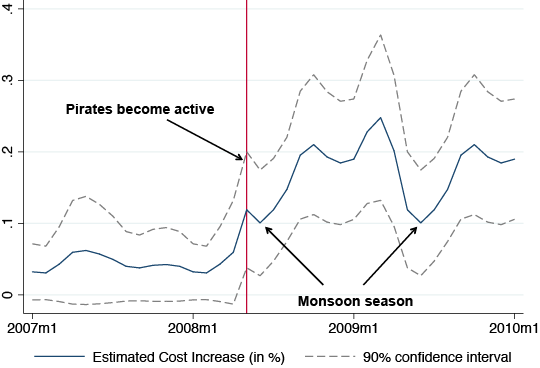Somalia has topped Foreign Policy’s list of failed states for the past five consecutive years. And this has fuelled an industry which reputedly generates around $120 million per year in net profits. But at what cost to the world?
Unlike organised extraction by the state in the form of taxation, piracy is disorganised predation. In the language of Olson (1993), pirates are roving bandits while the state is a stationary bandit and hence is in a better place to organise extraction of resources at lower costs. So the study of piracy is an ideal context to look at this issue empirically and to compare piracy with extracting resources through taxation.
By matching data on piracy attacks in the Somalia area to data on around 24,000 shipping contracts, we can estimate the impact of piracy on shipping costs. Our results suggest that shopping costs rise by around 10% when pirate activity increased in Somalia. The estimates also suggest that it is around 14% cheaper to charter ships through the Gulf of Aden during the summer monsoon (July-August) than in spring (March-April), when there is more piracy. And this seasonal pattern in shipping prices is absent prior to the upsurge in pirate activity in the region during 2008.

In the case of Somali piracy, ransoms transfer income to a poor country (Somalia) which go to a particular group i.e. organised criminals. It is far from clear how these benefits may trickle down to the wider population; Shortland (2011) provides some evidence that piracy revenue trickles into Somali society and has a positive developmental effect. We feel it is best to remain agnostic about this and base our welfare approach on Coate (2000). Using his reasoning, we should care principally that any transfer made to pirates is accomplished in the most efficient way and hence the welfare loss are the resources spent in the process of delivering the transfer.
Following this line of argument, we consider a thought experiment where we replace piracy with a tax on shipping, the proceeds of which are transferred to the pirates, yielding the exact level of net revenues as they now receive from engaging in piracy. We calculate that a tax rate of just 0.8% on chartering would be needed to generate a transfer of comparable magnitude to that generated by piracy. This contrasts with our estimates of an increase in shopping costs of between 8% and 12%. This makes the predatory activity of the kind undertaken by pirates between 10 and 16 times more costly than giving a similar level tax-financed transfer to pirates.
The key source of inefficiency of piracy attacks is that the increase in shipping charter rates due to piracy is not fully captured by the pirates. Piracy leads to additional costs on shippers, such as (i) the costs from the guard labour carried on board ships to combat piracy, (ii) direct damage to ships due to attacks, (iii) negotiation costs to release hijacked ships, and (iv) the cost of additional insurances demanded by ship owners.
Moreover, there are good reasons to believe that estimates based on the increase in shipping charter rates are a lower bound on the true welfare cost: (i) our core calculation does not factor in the demand response to these cost increases which would reduce trade, (ii) we focus on the costs by the charterer of a ship but some of the incidence could fall on ship owners, (iii) there are piracy related expenses which increase the cost of ship capacity and (iv) there are the costs of associated military operations by various nations. Taking any of these into account would only make piracy look even more inefficient as a resource transfer mechanism.
Another way of looking at the welfare cost of piracy is to realise that an industry worth $120 million a year in net profit to Somali pirates is creating increased spending on shipping costs of somewhere between $0.9 (the most conservative estimate) to $3.3 billion (the high-end estimate). To put this in context, we look at how many Somalis could be hired for one year using the additional resources that it estimate are expended by the shipping industry in response to the threat of piracy. Using wage data from the Somali Food Security and Nutrition Analysis Unit (FSNAU) presented we estimate a yearly wage of around $900. This means that the additional spending due to piracy could finance one year of employment for well over 1 million workers at the going market rate.
It is important to acknowledge that there is a wide range of plausible estimates of these costs and shipping costs is only one specific quantifiable aspect. Moreover examining this from the perspective of shipping costs does yield numbers for welfare costs which are quite a bit lower than are found in many consultancy reports. A key point of contention is how to measure the additional costs from military intervention; ships have to be crewed and paid for whether or not they are pursuing pirates, making this rather murky. We do add some such costs, albeit conservatively, into our high-end estimates. But quibbling over the exact numbers should not lose the focus on the bigger picture. Quantifying these costs and comparing them to the gains from the beneficiaries underlines the potential benefits of establishing a functional state in Somalia which can enforce law and order.
Further reading
Besley, T J., T Fetzer and H Mueller (2013), “The Welfare Cost of Lawlessness: Evidence from Somali Piracy”.
Coate, S, (2000), “An Efficiency Approach to the Evaluation of Policy Changes”, Economic Journal 110, pp. 437-455.
Olson, Mancur (1993), ""Dictatorship, Democracy, and Development"", American Political Science Review 87(3), pp. 567-576.
Shortland, A, (2011), ""Robin Hook"": The Developmental Effects of Somali Piracy. DIW Discussion Paper No. 1155.

